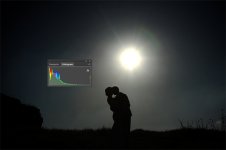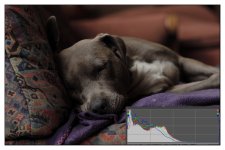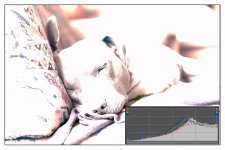You are using an out of date browser. It may not display this or other websites correctly.
You should upgrade or use an alternative browser.
You should upgrade or use an alternative browser.
Good looking histograms.....
- Thread starter 10 Gauge
- Start date
rocketman122
Senior Member
I know many look at a histogram to ok an exposure, but to me, I look at the image on the lcd and know if its good or not right away. the image you posted as a wide dynamic range. its the most simple in terms of what a good histogram looks like, but I get in situation where I shoot high key shots or low key shots and histogram wont tell a damn thing with that if we look at exposing for the graph. sillouettes, backlit, sidelit, whatever. a histogram will not do a damn thing to help you get proper exposure. its a trained eye that knows what hes seeing on the screen and adjust. it could be I have all the data on the left or to the right. its not always the case where its spread so nicely like your squirrel picture. and the reason mostly because you had an even diffused light in the scene. its also very nice. made me smile.


dennybeall
Senior Member
The histogram is an indicator to me but not a thing unto itself. It provides clues to tell if the shot is what I wanted it to be. Most important is seeing that parts are not blown out. It could be all to the left or all to the right or evenly spread. Each would be right for that shot.
I'm envious of those with cameras that will show the histogram before you take the shot. I have to shoot, check it, and then shoot again if needed.
I'm envious of those with cameras that will show the histogram before you take the shot. I have to shoot, check it, and then shoot again if needed.
rocketman122
Senior Member
The histogram is an indicator to me but not a thing unto itself. It provides clues to tell if the shot is what I wanted it to be. Most important is seeing that parts are not blown out. It could be all to the left or all to the right or evenly spread. Each would be right for that shot.
I'm envious of those with cameras that will show the histogram before you take the shot. I have to shoot, check it, and then shoot again if needed.
I couldnt care less if parts of the brides dress is burned or not. I care about exposing for face. it will happen often that you shoot outdoors in a sunny afternoon wedding and the faces are exposed and the whites will be burned out. I couldnt give a rats azz about that. its all about the exposures on the face. no one looks and no one cares. as long as the faces are nice and properly exposed.
Bourbon Neat
Senior Member
Firstly, nice squirrel capture Ten.
A histogram with everything jammed to the left is acceptable to your style? You are the photographer that shoots native iso exclusively? The link to an article about histograms actually argues against your approach. What do you think of the writer's viewpoint? https://luminous-landscape.com/understanding-histograms/
I notice when things are jammed to one side or the other on the histogram, there is bound to be clippings.
I only care about shadow clipping. With my shooting style there needs to be a supernova before I clip the highlights.
A histogram with everything jammed to the left is acceptable to your style? You are the photographer that shoots native iso exclusively? The link to an article about histograms actually argues against your approach. What do you think of the writer's viewpoint? https://luminous-landscape.com/understanding-histograms/
I notice when things are jammed to one side or the other on the histogram, there is bound to be clippings.
A histogram only reveals information about the shot as it is being displayed; not about the information it contains.
With the current generation cams I find little use in ISO. I can do the exposure of the shot as easily in post.
At 3200 ISO I gain about 1 stop of shadow improvement for the D810, 1/3th of a stop for the D750 and exactly zero gain for the D7200 at the expense of more than 5 stops of dynamic range, not to mention increased noise, loss of gray levels and color range.
Not worth it to me.
Once you know the limitations and work around them, and know how to process the shots, it doesn't matter how the initial histogram looks. And it doesn't imply there has been clipping because it is squeezed to the left.
With the current generation cams I find little use in ISO. I can do the exposure of the shot as easily in post.
At 3200 ISO I gain about 1 stop of shadow improvement for the D810, 1/3th of a stop for the D750 and exactly zero gain for the D7200 at the expense of more than 5 stops of dynamic range, not to mention increased noise, loss of gray levels and color range.
Not worth it to me.
Once you know the limitations and work around them, and know how to process the shots, it doesn't matter how the initial histogram looks. And it doesn't imply there has been clipping because it is squeezed to the left.
Last edited:
dennybeall
Senior Member
Agree that the faces are the most important but in many cases the dress, flowers, veils, etc. are very important to the bride. Especially the dress and accessories may be borrowed or the dress her mom and grandmom were wed in......
Nothing wrong with an artisan having personal opinions about what's important BUT when you're doing a job for someone else you need to consider what's important to them.
Nothing wrong with an artisan having personal opinions about what's important BUT when you're doing a job for someone else you need to consider what's important to them.
BackdoorArts
Senior Member
This one just kind of jumped out at me today while I was processing, thought it looked really good.
View attachment 164574
The real histogram freaks would look at this and tell you how this screams about all the white balance work you need to do because you have your colors peaking in different places. There's a science to that obsession, but I can't go there.
For me it's not a shape-thing, it's a breadth thing. If you've got a wall of data up against either end (i.e. lost shadows, blown out highlights) and you weren't looking for that, then you're improperly exposed. More importantly, for me, is if you've got something that looks like yours but there's space to the left and right of your curve. What that means is that you're losing tool effectiveness in those areas and your image is likely going to look more compressed than it could.
Here's an example of a toss away shot. On top you can see that there is lots of room to the right of the histogram, and a little to the left. This is very typical of cloudy day shots. On the bottom all I've done is moved the White and Black sliders so that the information I have covers the entire histogram (hold the alt/option key down when you do it and you'll see the lightest/darkest areas appear when you've crossed the boundary).
The white and black level will need to change as I adjust other things, but you can see how the flat image now has a bit of pop. This also means that anything curve related (highlight, shadow) will actually have data to work with, whereas prior to the adjustment the highlight slider likely would have had little effect.
The real histogram freaks would look at this and tell you how this screams about all the white balance work you need to do because you have your colors peaking in different places. There's a science to that obsession, but I can't go there.
Good thing I don't know any of those people. I process images to my liking an no one else's. I also never process an image based on the histogram, I could care less what it looks like, I just thought this one looked cool.
Sent from my HTC One M8 using Tapatalk
Good post, Jake. Your description explains how the histogram can be a valuable tool. I find it to be an important part of my post processing.
I also agree with Rocketman that you should certainly not be a slave to the histogram and use your eyes to ultimately determine what is or is not a good exposure. The most important tool you have at your disposal is your own eyes.
The histogram is a tool, nothing more.
Over and out.
I also agree with Rocketman that you should certainly not be a slave to the histogram and use your eyes to ultimately determine what is or is not a good exposure. The most important tool you have at your disposal is your own eyes.
The histogram is a tool, nothing more.
Over and out.
The real histogram freaks would look at this and tell you how this screams about all the white balance work you need to do because you have your colors peaking in different places. There's a science to that obsession, but I can't go there.
How is that possibly applicable in this image? (rhetorical). Peaking in different places can be important to white or gray things, because their definition is that they have equal RGB components (and equal in white is the meaning of white balance).
But it hardly applies to green grass or red bricks, they have no supposed relationship. "Where" they peak depends NOT on brightness, but a peak is only about HOW MANY pixels there are with components of that same color value, be it dark or bright. That in turn simply depends on the image content, about what we aim the camera at. There are no hard rules about aiming the camera.
It really does Not matter what the shape of this or any histogram is. Scenes vary, and histograms vary. Some scenes have bright content, others have dark content. A histograms shape is what it is. We can affect it with lighting and exposure though.
It is normally good (in average pictures) to not have much blank space at right end, which can often imply more exposure might have been a good thing (only if assuming we have some white or bright objects that ought be bright up there).
There is no blank space on either right or left end of this one. Both ends are clipped in some degree.
But what is most important is the clipping at the 255 right end. This one has the slightest red clipping of the red bricks, not enough to matter much, if at all. Daylight and Flash WB tends to cause red to clip a bit. Importance kinda depends on what it is that clips, if there is any important detail lost.
The significant trick to learn in Lightroom (or other Adobe Camera Raw) is that (for temporary examination purposes) you can hold down the ALT key (Windows, or Option key in Mac) while increasing the EXPOSURE slider (this is also true of holding ALT on the Adobe Levels tool White and Black Point sliders). Holding that ALT key and then touching the Exposure slider then instead shows WHICH PIXELS are being clipped at 255 (at the present Exposure slider value). Clipping loses detail in those clipped pixels. Here, any clipping is just the highlight on the top of the red brick behind the squirrel. Depends on how fussy you are, but it does not hurt any important detail here, nothing important is lost. You can judge it and adjust brighter exposure (more clipping), or less exposure, which in slight degree, might sometimes appear to regain a bit of detail (but clipping the camera is lost and unrecoverable detail).
Holding ALT while sliding the BLACKS slider shows the same thing at the black end. Here, red is more severely clipped at the dark end, simply because there is no red in that green grass, red has zero value there (red and green are compliments, or opposites). Red should be zero in colors that have no red component (and we have many of them here).
I think this histogram is showing that there is no better exposure of this scene. We could however arbitrarily make it brighter, by increasing the clipping on the top of the red brick edging.
BackdoorArts
Senior Member
How is that possibly applicable in this image? (rhetorical). Peaking in different places can be important to white or gray things, because their definition is that they have equal RGB components (and equal in white is the meaning of white balance).
I didn't say it was applicable to me with this image, I'm saying that I've seen lessons on White Balance using the histogram where the person will have you doing level adjustments basked on seeing peaks like this. To quote myself, I started with, "The real histogram freaks...". Were I one of them then I would have launched into an explanation.
I didn't say it was applicable to me with this image, I'm saying that I've seen lessons on White Balance using the histogram where the person will have you doing level adjustments basked on seeing peaks like this. To quote myself, I started with, "The real histogram freaks...". Were I one of them then I would have launched into an explanation.
OK, but when I quoted you, you said "The real histogram freaks would look at this and tell you how this screams about all the white balance work you need to do because you have your colors peaking in different places."
I didn't think this did that at all.
The main thing I think important to know about histograms is that in regard to clipping, the single gray histogram in the camera is useless. It is NOT real data at all. Instead it is a math abstraction that shows grayscale luminance instead of clipping. ( There are Two Different types of Histograms )
We should ONLY look at the three RGB histograms in the camera (which are real data). Sometimes (D3100) the RGB histograms is a menu in Playback that is not on by default. Adobe histograms show it correctly.
Blade Canyon
Senior Member
Firstly, nice squirrel capture Ten.
You are the photographer that shoots native iso exclusively? The link to an article about histograms actually argues against your approach. What do you think of the writer's viewpoint? https://luminous-landscape.com/understanding-histograms/
J-See is obviously famous for his unique stance on "ISO-less" shooting. Thank you for posting that article. I don't think it argues against J-See's method of shooting, however. The value I got from it was how to use the histogram to read the entire dynamic range of a scene. Currently I would do that with spot metering, but the author shows a good example of how to use the histograms from two different exposures. A histogram is obviously important in post processing because it's how we set levels to get the most info in our final shot.
I generally agree with J-see on this point: if you need a minimum shutter speed to capture action and prevent blur, and you need a certain aperture to get a proper depth of field, then it doesn't matter where your ISO is set so long as you are shooting in RAW. The sensor will record the exact same amount of light no matter where your ISO is set. Others who have argued against this approach were not leaving the shutter speed and aperture at the same settings. I did my own experiments, and adjusting the ISO in post with a RAW file achieved the exact same result as adjusting ISO before the shot.
On the other hand, however, there was this very technical article posted by Backdoor Hippie or Horoscope Fish or Hark or one of the regulars:
theory.uchicago.edu/~ejm/pix/20d/tests/noise/
And here's the most relevant quotation from that article:
"Bottom line: Read noise at high ISO is much smaller than read noise at low ISO, in terms of the error in photon counting that it represents. Thus, better image quality is obtained for using the highest ISO for which the signal is not clipped."
J-see says his experience with newer cameras is different. My experiments show no difference.



